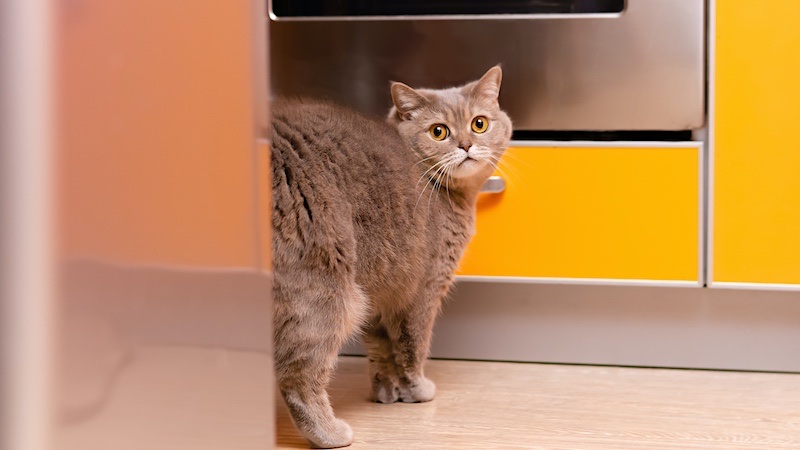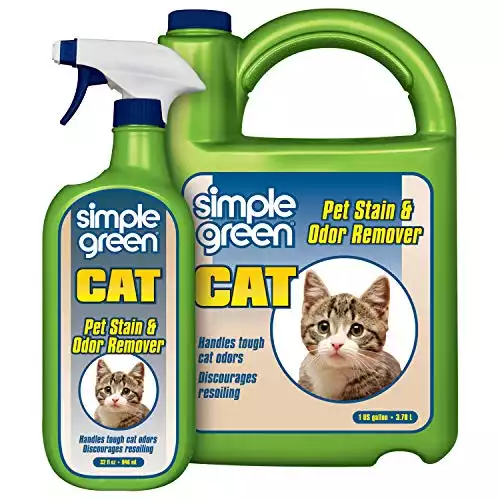Having an indoor cat is a rewarding experience, but it can also bring unexpected challenges like cleaning cat spray off walls. Many pet owners are surprised to find their beloved feline friend marking walls and furniture with its urine as a way of claiming territory or expressing stress.
It’s important to understand why your cat does this so you can take steps to reduce the chances of spraying happening again in your home – while learning how best to clean cat spray off wall.
From using natural cleaners that remove unpleasant odors, to providing enriching activities for your kitty companion, there are lots of ways you can keep both yourself and your furry pal happy without any smelly surprises.
Understanding Cat Spraying

What is Cat Spraying?
Cat spraying, also known as urine marking, is a common behavior among cats. It involves the cat urinating on vertical surfaces such as walls or furniture in order to mark their territory.
This type of behavior is different from regular urination, which usually occurs on horizontal surfaces like floors and carpets. A Cat will often spray indoors when they feel threatened or stressed by changes in their environment.
Why Do Cats Spray?
Cats spray for a variety of reasons, including territorial disputes with other cats or animals, fear of unfamiliar people or objects in the home, and even boredom due to lack of stimulation. Additionally, cats may spray if they are feeling overwhelmed by too many humans in the house or if there has been an introduction of a new pet into the home.
How to Identify Cat Spraying?
Cat spraying can be identified by its pungent odour and look; it often has a strong, ammonia-like scent that stays for an extended period of time after the event.
The urine itself will appear darker than normal because it contains more concentrated amounts of proteins and hormones that help mark territory for other cats in the area.
In addition, you may notice your cat scratching at certain areas before they begin spraying – this is done as part of their scent-marking process.
By understanding the reasons why cats urine, we can work to prevent it from happening in the future and focus on cleaning up any existing messes. Next, let’s look at how to clean cat spray off walls safely and effectively.
Cleaning Cat Urine Streaks Off Wall
Removing Fresh Cat Urine Stains:
When it comes to cleaning cat urine off walls, the first step is to remove any fresh urine stains. Blot the wetness with a cloth or paper towel to absorb any fresh urine residue.
If you have access to an enzymatic cleaner, this can be used on the urine stain for better results. Enzymatic cleaners work by breaking down proteins in the stain so that they can be more easily removed during the cleaning process. Be sure to follow all instructions on the product label when using these cleaners.
This enzyme cleaner permanently eliminates tough stains and unpleasant odors from cat spraying, urine, feces, vomit, dirt, blood and more.
32 oz bottle plus a 1 gallon refill.
Dealing with Old Urine Stains:
For old urine stains that have been left untreated for some time, there are a few steps you should take before attempting to clean them off your wall. First, make sure that you wear protective gloves and safety glasses while handling any chemical-based products like bleach or ammonia solutions.
Once you’ve done this, mix one part white vinegar with two parts water in a spray bottle and lightly mist over the area where the urine stain is located until it is completely saturated. Allow this solution to sit for several minutes before wiping away with a damp cloth or sponge.
Repeat if necessary for stubborn stains until all traces of cat urine are gone from your wall surface.
Once the urine has been removed from your walls, it is important to take steps to prevent future accidents by providing a safe and stimulating environment for your cat. By ensuring proper nutrition, exercise, and reducing stress in their environment, you can help reduce the likelihood of spraying incidents in the future.
Recap: Cleaning cat urine off walls requires a few steps, such as blotting up fresh urine stains and using an enzymatic cleaner or a vinegar solution to treat old ones.
Caring for an Indoor Cat to Reduce Spraying
Providing Stimulation and Exercise:
Keeping your indoor cat active is essential in reducing spraying behavior. Cats are naturally curious creatures, so providing them with plenty of toys and activities can help keep their minds stimulated.
Consider getting a scratching post or interactive toy that encourages your cat to move around and explore its environment. An outdoor cat enclosure is ideal if you work all day. Putting your cat in an outdoor enclosure keeps him safe while providing plenty of stimulation.
If this isn’t possible because you live in an apartment you should try and make sure to set aside time each day for playing with your cat. This will not only provide physical exercise but also give them mental stimulation as they learn how to interact with you and other objects in the home.
Creating a Stress-Free Environment:
To reduce spraying behavior, it’s important to create a stress-free environment for your indoor cat. Make sure there are enough hiding spots throughout the house where they can go when feeling overwhelmed or scared.
You should also avoid overcrowding the space by limiting visitors or other pets if possible, as this can be stressful for cats who don’t like change or unfamiliar faces/animals in their territory.
Finally, try introducing calming scents such as lavender oil into the air which may help relax anxious cats and reduce stress levels overall.
By following these simple tips, you should be able to keep your indoor cat happy and healthy while reducing any unwanted behaviors such as excessive spraying. By providing the proper care and consideration, you can ensure that your furry companion remains content within their domicile without having to fret over any unanticipated difficulties.
Recap: By providing stimulation and creating a stress-free environment, indoor cats can be kept happy and healthy while reducing any unwanted behaviors such as spraying.
Conclusion
It is important to understand why your cat is behaving this way and how to clean cat spray off walls. By understanding the behavior of cats, you can reduce or even prevent spraying from happening in the first place.
If your indoor cat does happen to spray, it’s essential that you take steps to clean up the mess as soon as possible. Cleaning cat urine smell requires special cleaning products designed specifically for this purpose. With a little patience and effort, you can get rid of any lingering odors caused by cat spraying and keep your home smelling fresh again.
Do you want to keep neighbourhood cats out of your garden and give the best care possible for an indoor cat? Don’t worry, I have solutions! I can help you identify effective strategies that will make sure cats stay away from your yard while providing a safe and comfortable environment for your feline friend indoors.
From odor repellents to pet-proofing tips, my resources are designed to ensure both outdoor and indoor cats get what they need in order to be happy and healthy. Let’s work together so that everyone is content – take action now!






